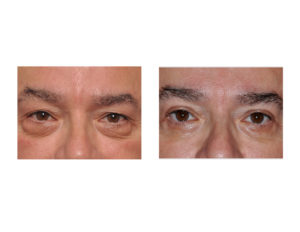While cosmetic eyelid surgery is very common, there are major differences between the upper and lower blepharoplasty procedure. This is primarily due to the much more static but suspensory nature of the lower eyelid. This makes it much more unforgiving than the upper eyelid and even slight disruptions of support or scar contracture creates lid malposition. This challenge is magnified in the thick-skinned lower eyelid patient.

The use of a transconjunctival approach for herniated fat removal or transposition when there is no significant skin redundancy. A preseptal approach is preferred over the post septal approach.

Patients with positive preoperative snap and distraction lower eyelid tests should have either canthopexy or a canthoplasty. When mild support is needed a canthopexy using the inner edge of the lateral orbital rim periosteum. When more support through a horizontal lid shortening is needed a tarsal strip technique is used.
When lower lid skin resurfacing is indicated a medium depth peel of either 35% TCSA or 88% phenol is used.
The use of Botox injections, either before or after lower blepharoplasty, for crow’s feet is unchanged from thin skinned patients.
While the management of the thick-skinned lower eyelid patients has some unique considerations, successful outcomes with a low incidence of manageable complications can result.
Dr. Barry Eppley
Indianapolis, Indiana


